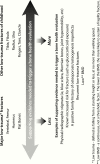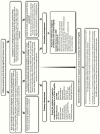A Contemporary View of the Definition and Diagnosis of Osteoporosis in Children and Adolescents
- PMID: 31865390
- PMCID: PMC7121121
- DOI: 10.1210/clinem/dgz294
A Contemporary View of the Definition and Diagnosis of Osteoporosis in Children and Adolescents
Abstract
The last 2 decades have seen growing recognition of the need to appropriately identify and treat children with osteoporotic fractures. This focus stems from important advances in our understanding of the genetic basis of bone fragility, the natural history and predictors of fractures in chronic conditions, the use of bone-active medications in children, and the inclusion of bone health screening into clinical guidelines for high-risk populations. Given the historic focus on bone densitometry in this setting, the International Society for Clinical Densitometry published revised criteria in 2013 to define osteoporosis in the young, oriented towards prevention of overdiagnosis given the high frequency of extremity fractures during the growing years. This definition has been successful in avoiding an inappropriate diagnosis of osteoporosis in healthy children who sustain long bone fractures during play. However, its emphasis on the number of long bone fractures plus a concomitant bone mineral density (BMD) threshold ≤ -2.0, without consideration for long bone fracture characteristics (eg, skeletal site, radiographic features) or the clinical context (eg, known fracture risk in serious illnesses or physical-radiographic stigmata of osteoporosis), inappropriately misses clinically relevant bone fragility in some children. In this perspective, we propose a new approach to the definition and diagnosis of osteoporosis in children, one that balances the role of BMD in the pediatric fracture assessment with other important clinical features, including fracture characteristics, the clinical context and, where appropriate, the need to define the underlying genetic etiology as far as possible.
Keywords: DXA; bone mineral density; children; definition; diagnosis; fractures; long bone; osteogenesis imperfecta; osteoporosis; risk factors; vertebral.
© Endocrine Society 2019. All rights reserved. For permissions, please e-mail: journals.permissions@oup.com.
Figures
References
-
- Writing Group of the ISCD Position Development Conference. Diagnosis of osteoporosis in men, premenopausal women, and children. J Clin Densitom. 2004;7:17–26. - PubMed
-
- Ma J, McMillan HJ, Karagüzel G, et al. The time to and determinants of first fractures in boys with Duchenne muscular dystrophy. Osteoporos Int. 2017;28(2):597–608. - PubMed
-
- Ward LM, Ma J, Lang B, et al. ; Steroid-Associated Osteoporosis in the Pediatric Population (STOPP) Consortium . Bone morbidity and recovery in children with acute lymphoblastic leukemia: results of a six-year prospective cohort study. J Bone Miner Res. 2018;33(8):1435–1443. - PubMed
-
- LeBlanc CM, Ma J, Taljaard M, et al. ; Canadian STeroid-Associated Osteoporosis in Pediatric Population (STOPP) Consortium . Incident vertebral fractures and risk factors in the first three years following glucocorticoid initiation among pediatric patients with rheumatic disorders. J Bone Miner Res. 2015;30(9):1667–1675. - PMC - PubMed
-
- Whyte MP, Greenberg CR, Salman NJ, et al. Enzyme-replacement therapy in life-threatening hypophosphatasia. N Engl J Med. 2012;366(10):904–913. - PubMed



